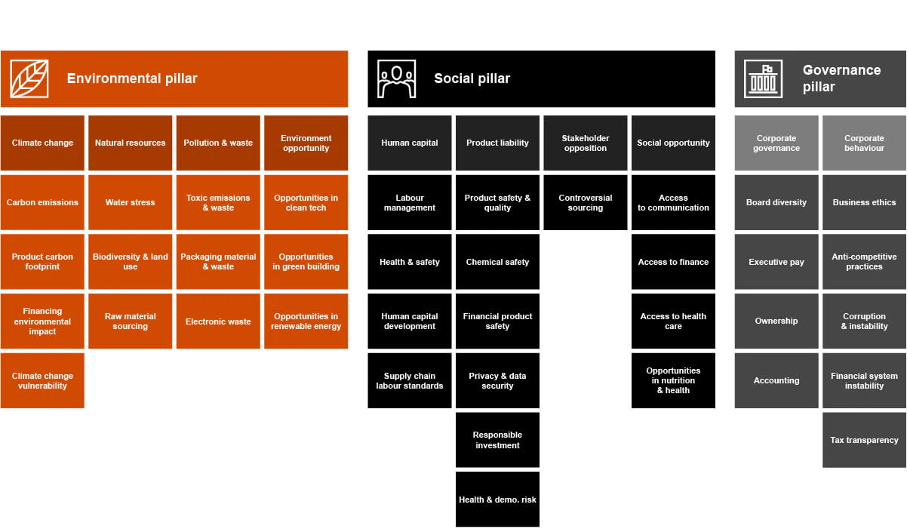- ESG reporting is a vital tool businesses use to attract and retain investors and consumers.
- Gas analyzers help keep people, facilities, the environment, and communities safe from toxic and hazardous gases’ safety and health effects.
- Gas analyzers can help reduce environmental risks, meet social responsibility obligations, and provide objective data for ESG compliance.
Environmental, Social, and Governance (ESG) reporting is gaining importance among businesses, investors, and consumers. ESG’s focus has mainly been on the environment and governance. Still, social responsibility that covers workers’ occupational health and safety and the impact on neighboring communities is equally crucial. Find out more about how gas analyzers can help with ESG compliance.
ESG Factors for Industries
Sustainability reports are submitted by businesses to provide non-financial information on the environmental impacts, social responsibility, and governance aspects of their operations. It also covers the risks and opportunities for a company based on ESG factors. The reports are objective and based on scientific data that can provide transparency to a company’s claim on its activities. A list of factors that are usually considered for ESG reporting is mentioned in Figure 1, but the main focus for ESG is summarized below:
Environment: Several industries, such as manufacturing, pharmaceuticals, oil and gas, must deal with toxic and hazardous substances. Accidental leaks and explosions can pollute air, water, and soil. ESG reports must cover these environmental impacts and risks.
Social: The daily working conditions that involve emissions that lead to poor air quality under which personnel work can have acute and chronic health effects. Fires and explosions due to accidental leaks or lack of proper work protocol can sometimes lead to fatalities. Regular or unintentional leaks and explosions from industries like mining, manufacturing, etc., can also harm the neighboring community and pollute the environment.
Governance: Corporate governance determines the environmental and social impact of a business. Governance will include aspects such as business ethics, broad composition and diversity, anti-corruption, risk and crisis management, resource allocation, transparency, fair competitive practices, accurate accounting methods, whistle-blower protection, stakeholder engagement, and supply chain management.
Organizations that evaluate ESG factors can benefit from compliance with national, international, and industry standards and also use the opportunity to identify operational problems and improve productivity.

Figure 1: Industries can choose factors relevant to their operations from this list of ESG factors provided by EU.’s Corporate Sustainability Reporting Directive (CSRD). (Image credits: PWC)
Occupational Health and Safety
Social responsibility by employers, which is not adequately covered, is becoming a significant area of focus in sustainability and non-financial reporting.
Companies with demonstratable occupational health and safety (OHS) programs are perceived as more responsible, ethical, and sustainable. Investors are beginning to evaluate businesses and industries based on their OHS standards during decision-making as it reduces risks. Therefore, OHS, which involves procedures, protocols, practices, and policies integrating workers’ physical, social, and mental health, is becoming essential for ESG reporting.
Businesses that focus on occupational health and safety also benefit through improved productivity due to employees’ health. Employers demonstrating their involvement in OHS can win personnel’s loyalty and improve performance.
Therefore, companies will need to make OHS central to their operations. They will need to conduct risk management, develop safety programs with the help of internal or external industrial hygienists, and appoint safety managers to oversee the implementation of OHS. In many countries, including the USA, OHS management is mandatory.
Businesses need efficient machinery, infrastructure, gas detectors, and personal protective equipment (PPE) to achieve a safe and healthy workspace. Training in safe work procedures, gas detectors, PPE, and information sharing on workers’ dangers are crucial elements of any safety plan.
What Gas Analyzers Measure
Industries can be unsafe and unhealthy due to the use or production of dangerous substances, such as gases, liquids, and solids, which need to be monitored and controlled. Gas analyzers help to monitor the environment for dangerous gases.
The dangerous gases that are present in industrial workplaces can be toxic, inert, or hazardous:
- Toxic gases: These gases can be colorless to colored, with or without distinctive smells, of varying densities. Personnel may be exposed to these gases through contact with skin and eyes or inhalation that affects the nose and respiratory system. The toxic gases can have serious acute and chronic health effects, sometimes even leading to death. Examples of poisonous gases are ammonia, hydrogen sulfide, carbon monoxide, etc.
- Inert gases: Inert gases have no health effects and are non-reactive, but they are dangerous as they replace oxygen and can cause asphyxiation. The danger is usually caused by acute exposure to gases such as argon, helium, and nitrogen.
- Hazardous gases: Several gases and vapors are flammable and explosive. They burn and explode when they encounter a heat source and oxygen. Leaks from cylinders can lead to explosions. Such hazardous gases can harm or kill workers, destroy the facility, and damage and pollute the neighborhood. A few toxic gases, such as hydrogen sulfide, are also flammable.
These gases can be life and health-threatening in trace quantities measured in parts per billion (ppb) or parts per million (ppm) by volume. Precision gas analyzers are necessary to measure these trace levels.
Given the significant damage gases can cause, prescribed limits are set to control them. Some limits, like those set by the Occupational Safety and Health Administration (OSHA), are legally binding in the USA, and employers must show records to prove that the gases in their facilities are safe.
Gas Analyzers
Employers can use Fixed Gas Analyzers and Portable Gas Analyzers for the above purposes.
- Fixed gas analyzers: These sensors are mounted on the wall. Many sensors that measure different gases are connected to a central unit and are meant for facility safety. They are attached to engineering mechanisms like value closure or increasing ventilation to control gas levels.
- Portable gas analyzers: The staff carry portable sensors when they work in high-risk areas such as confined spaces.
Both types of detectors have visual and audio alarms.
How Gas Analyzers Help
The ESG benefits of using the gas analyzers are as follows.
- Protect the environment: Gas analyzers are instrumental in protecting the environment by monitoring gas levels and limiting leaks and accidents.
- Reduce carbon emissions: Industries produce greenhouse gases (GHG) that can also be hazardous, such as methane and nitrous oxide. Any measure to reduce these gases reduces a company’s carbon footprint.
- Emergency actions: If the gas levels go beyond permitted limits, the audio and visual alarms provide early warnings and alert staff, who can take corrective actions like evacuation and control measures to limit leaks or damage. Prompt action can save lives, property, and the environment.
- Maintain safe working conditions: The industrial environment is safe because reliable gas analyzers constantly monitor it. This approach protects workers physically and mentally well. Employees can focus on their work and improve productivity, too.
- Community safety: Measures like gas analyzers can control negative environmental, safety, and health impacts on neighborhoods. They ensure that industries like mining or manufacturing facilities meet their social responsibility towards local communities.
- Record of exposure: Portable gas analyzers collect data that can be transferred through USB after use. The fixed gas analyzers have data-logging capabilities that provide information on acute and chronic gas exposure levels. These are valuable data to add to personnel medical records to ensure optimal diagnosis and healthcare.
- Compliance: The data collected by portable and fixed gas analyzers can be recorded directly to provide objective data on air quality and levels of toxic and hazardous gases. These can be connected to other software systems for easy ESG reporting and compliance.
Protection of the environment, reduction of carbon footprint, and timely emergency actions address the “E” factor. At the same time, safe working conditions and emergency actions address the “S” factor. Recording exposure and data logging and analysis helps comply with the “G” aspects of ESG reporting.
Compliance Requirements
The ESG reporting requirements vary globally, with the most stringent regulations in regions like Europe.
European Union (EU): The EU has long made ESG reporting mandatory for large enterprises. These provisions have been made stricter in the Corporate Sustainability Reporting Directive (CSRD), which came into force in Jan 2023. Compliance has been widened to include more businesses, including listed small and medium enterprises (SMEs) and non-EU companies with a market of over 150 million Euros in the EU market.
The Corporate Sustainability Due Diligence Directive (CSDDD) in the EU came into effect in July 2024. It focuses on sustainability in companies’ operations and global value chains, covering environmental impacts and human rights.
USA: ESG compliance has been voluntary in the USA until now. In 2022, the Securities and Exchange Commission (SEC) presented a proposal to cover ESG. In October 2024, aspects relating to carbon emissions and human capital management are expected to be updated.
Sustainability Accounting Standards Board (SASB) guidelines are not mandatory but are used by US corporations to meet investor requirements for ESG data. Businesses must also meet state regulations, such as California’s Climate Corporate Data Accountability Act, if applicable.
International standards: Several global ESG reporting standards, like the International Sustainability Standards Board (ISSB) and the Global Reporting Initiative (GRI), are also available for voluntary ESG reporting.
Since 2023, several countries in Asia, South America, and Africa have also adopted ESG regulations. Havard Law School Forum expects ESG regulations and enforcement to increase from 2024 onwards. Hence, businesses can no longer avoid OSH and ESG considerations.
Interscan Gas Analyzers
Businesses interested in improving OSH for ESG reporting must acquire reliable gas analyzers. Interscan offers gas sensors based on state-of-the-art technology and science. Accusafe and GasD 8000 systems provide fixed and portable gas detection to monitor twenty dangerous gases. The tools are suitable for various industries.
Find out more details on how our products can help your company in OHS and ESG compliance, and request a quote from Interscan’s experts.
Sources
Birch, K. (2024, Jan 7). ESG regulation: what companies should prepare for in 2024. Retrieved from https://sustainabilitymag.com/esg/esg-policy-and-regulation-what-to-prepare-for-in-2024
Burkinshaw, A. (2024, Jan 2). ESG regulation in 2024: Everything you need to know. Retrieved from https://sustainability-news.net/policy-and-regulation/2024-guide-to-esg-regulation/
Davies, P. A., Fortt, S. E., Huber, B.M., Latham, & Watkins, L.L.P. (2024, Jan 30). ESG Insights: 10 Things That Should Be Top of Mind in 2024. Retrieved from https://corpgov.law.harvard.edu/2024/01/30/esg-insights-10-things-that-should-be-top-of-mind-in-2024/
EU Commission. (n.d.). Corporate sustainability reporting. Retrieved from https://finance.ec.europa.eu/capital-markets-union-and-financial-markets/company-reporting-and-auditing/company-reporting/corporate-sustainability-reporting_en#legislation
Kube, D. (2023, April 12). The Intersection of ESG and Occupational Health and Safety: Prioritizing People and Planet. Retrieved from https://www.linkedin.com/pulse/intersection-esg-occupational-health-safety-people-kube-ep-chsc
Mirza, Z. (2024, July 10). SEC’s ESG greenwashing, human capital disclosure rules pushed to October. Retrieved from https://www.esgdive.com/news/secs-esg-greenwashing-human-capital-disclosure-rules-pushed-to-october/721012/
Silk, D. M., & Lu, C.X. W. (2024). Environmental, Social, & Governance Law USA 2024. Retrieved from https://iclg.com/practice-areas/environmental-social-and-governance-law/usa.
The Investopedia Team. (2024, July 30). What Is ESG Investing? Retrieved from https://www.investopedia.com/terms/e/environmental-social-and-governance-esg-criteria.asp
Tsalis, T. A, Malamateniou, K. E., Koulouriotis, D., Nikolaou, I. E. (2020). New challenges for corporate sustainability reporting: United Nations’ 2030 Agenda for sustainable development and the sustainable development goals. Corp Soc Responsib Environ Manag.;1–13. https://doi.org/10.1002/csr.1910TSALIS ET AL. 13
WEF. (2022, June). Defining the ‘G’ in ESG Governance Factors at the Heart of Sustainable Business. Retrieved from https://www3.weforum.org/docs/WEF_Defining_the_G_in_ESG_2022.pdf


